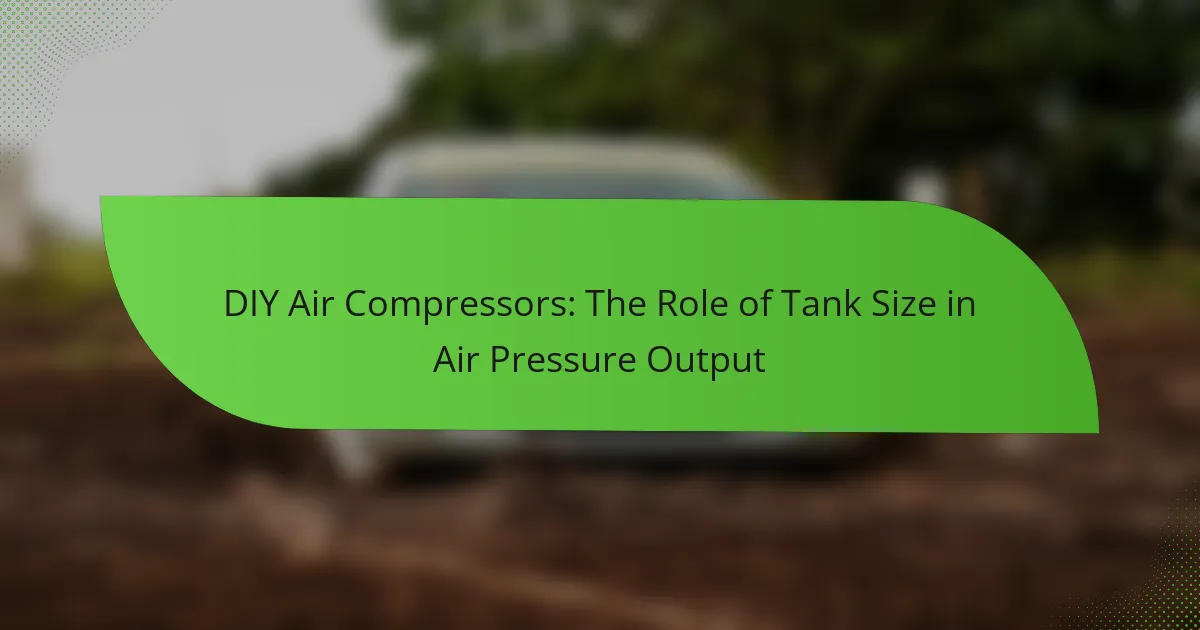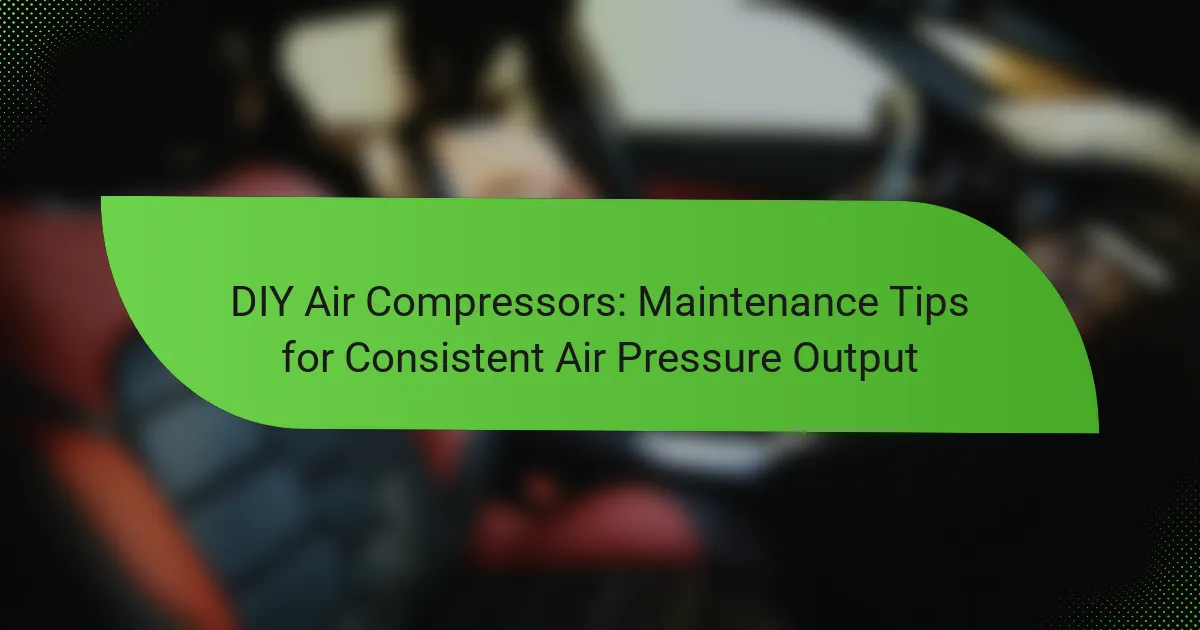DIY air compressors are devices designed to compress air for various practical applications, including tire inflation, powering pneumatic tools, and paint spraying. This article explores the relationship between cubic feet per minute (CFM) and air pressure output in DIY air compressors, highlighting common construction methods such as using modified refrigerator compressors and portable air tanks. It also emphasizes the benefits of customization and shares insights from enthusiasts who provide valuable online resources for building effective compressors. Overall, readers will gain a comprehensive understanding of how to optimize air compression for their specific needs.

What are DIY Air Compressors?
DIY air compressors are devices that compress air for various applications. They are often built from readily available materials and components. These compressors can be used for inflating tires, powering pneumatic tools, or spraying paint. The DIY approach allows for customization based on specific needs. Common designs include using a modified refrigerator compressor or a portable air tank. Many enthusiasts share their designs and experiences online. These resources provide valuable guidance for constructing effective DIY air compressors. Overall, DIY air compressors offer a cost-effective solution for air compression needs.
How do DIY Air Compressors function?
DIY air compressors function by converting power into potential energy stored in pressurized air. They typically use an electric motor or gas engine to drive a piston or diaphragm. This mechanism compresses air into a storage tank. The compressed air accumulates in the tank until it reaches a specified pressure. Once this pressure is achieved, the compressor automatically shuts off. When tools or equipment require air, the stored compressed air is released. The relationship between cubic feet per minute (CFM) and air pressure output is crucial for determining the compressor’s efficiency. Higher CFM ratings indicate more air delivery at a given pressure, affecting performance in various applications.
What components are essential for building a DIY Air Compressor?
A DIY air compressor requires several essential components. These include a motor, which powers the compressor. A pump is necessary to compress the air. A storage tank holds the compressed air for use. Additionally, pressure gauges monitor the air pressure levels. Hoses and fittings connect the components for air flow. A regulator controls the output pressure. Lastly, an air filter ensures clean air enters the system. Each component plays a critical role in the compressor’s functionality.
How do these components interact to produce compressed air?
Air compressors produce compressed air through the interaction of several components. The main components include the motor, pump, tank, and pressure switch. The motor powers the pump, which draws in atmospheric air. The pump compresses this air, increasing its pressure. The compressed air is then stored in the tank. The pressure switch monitors the air pressure in the tank. When the pressure reaches a set level, the switch turns off the motor. This cycle continues, maintaining a steady supply of compressed air. The interaction of these components ensures efficient air compression and storage.
What is the significance of CFM in DIY Air Compressors?
CFM, or Cubic Feet per Minute, is significant in DIY air compressors as it measures the airflow rate. A higher CFM indicates greater air delivery, which is essential for powering tools effectively. Many air tools require specific CFM ratings to operate efficiently. For example, a nail gun typically needs around 2 to 4 CFM, while a spray gun may require 10 CFM or more. Understanding CFM helps users select the right compressor for their specific needs. Additionally, insufficient CFM can lead to reduced tool performance and longer project times. Therefore, matching the CFM rating of the compressor to the tools used is crucial for optimal results.
How is CFM measured in air compressors?
CFM, or cubic feet per minute, is measured in air compressors by assessing the volume of air the compressor can deliver in one minute. This measurement is typically taken at a specific pressure level, often 90 PSI, to provide a standardized reference. To measure CFM, a flow meter can be attached to the air compressor’s output. The flow meter calculates the air volume passing through it over a minute. Additionally, manufacturers may provide CFM ratings in product specifications. These ratings indicate the compressor’s capacity under certain conditions, ensuring users understand its performance capabilities.
What factors influence CFM ratings in DIY setups?
CFM ratings in DIY setups are influenced by several key factors. The size of the air compressor tank affects the CFM output. Larger tanks can store more air, allowing for higher CFM ratings. The motor power also plays a critical role. A more powerful motor can generate higher airflow, increasing CFM. Additionally, the design of the compressor, including the type of pump used, impacts CFM ratings. Certain pumps, such as twin-cylinder designs, can produce more airflow than single-cylinder models. The diameter and length of the air hoses can restrict airflow, thereby affecting CFM. Lastly, the operating pressure of the compressor influences the CFM output. Higher pressure settings can reduce the CFM available for tools. These factors collectively determine the efficiency and effectiveness of DIY air compressor setups.
Why is air pressure output important in DIY Air Compressors?
Air pressure output is crucial in DIY air compressors because it determines the efficiency and effectiveness of the tools powered by the compressor. Higher air pressure allows for better performance in applications such as painting, inflating, and powering pneumatic tools. The required air pressure varies depending on the specific task; for example, spray painting typically requires 30-50 PSI, while nail guns may need 70-100 PSI. Insufficient air pressure can lead to inconsistent results and reduced tool functionality. Therefore, understanding the air pressure output ensures that users can select the right compressor for their needs. This knowledge can prevent equipment damage and enhance overall project quality.
How does air pressure affect the performance of a DIY Air Compressor?
Air pressure significantly affects the performance of a DIY air compressor. Higher air pressure increases the compressor’s ability to deliver more compressed air. This results in improved efficiency and performance in powering tools. Conversely, insufficient air pressure can lead to underperformance and inadequate airflow. The compressor’s capacity to maintain a specific CFM (cubic feet per minute) output is directly tied to the air pressure generated. For example, a compressor operating at 90 PSI can typically deliver a higher CFM than one at 40 PSI. This relationship is crucial for tasks that require consistent air supply, such as painting or pneumatic tool operation. Properly managing air pressure ensures optimal performance and extends the lifespan of the compressor.
What are the common air pressure standards for various applications?
Common air pressure standards for various applications include 30 psi for pneumatic tools, 60-90 psi for spray painting, and 100-120 psi for air compressors. These standards ensure optimal performance and safety across different uses. For instance, pneumatic tools typically operate effectively at lower pressures around 30 psi. Spray painting requires a range of 60-90 psi to achieve a fine mist without overspray. Air compressors are often set between 100-120 psi to provide sufficient power for various tasks. These standards are widely recognized in the industry and help maintain equipment efficiency.
How do CFM and air pressure output relate to each other?
CFM (Cubic Feet per Minute) and air pressure output are inversely related. As CFM increases, the air pressure output typically decreases. This relationship occurs because a higher volume of air requires a lower pressure to maintain flow. Conversely, if air pressure is increased, the CFM output is reduced. For example, a compressor rated for 10 CFM at 90 PSI may only provide 7 CFM at 120 PSI. This principle is crucial for selecting the right compressor for specific applications. Understanding this relationship ensures optimal performance in DIY projects.
What is the relationship between CFM and PSI in air compressors?
CFM (Cubic Feet per Minute) and PSI (Pounds per Square Inch) are critical metrics in air compressors. CFM measures the volume of air delivered, while PSI gauges the pressure of that air. The relationship between them is inversely proportional. As PSI increases, CFM typically decreases, assuming a constant horsepower. This is due to the compressor’s design and limitations. Higher pressure requires more energy, which can reduce airflow. For example, a compressor rated for 90 PSI may deliver 5 CFM, while at 40 PSI, it can deliver 10 CFM. Understanding this relationship helps users select the right compressor for their needs.
How can understanding this relationship improve DIY projects?
Understanding the relationship between CFM and air pressure output can significantly enhance DIY projects. This knowledge allows for the selection of the right air compressor for specific tasks. For example, different tools require varying CFM and pressure levels to operate efficiently. Knowing these requirements helps avoid underperformance or damage to tools. Additionally, it enables better planning for project timelines and material usage. Research indicates that proper air compressor settings can improve tool longevity and performance. Accurate matching of CFM and pressure can lead to more effective and satisfying DIY outcomes.
What are the common challenges in balancing CFM and air pressure?
Common challenges in balancing CFM and air pressure include achieving optimal airflow while maintaining pressure levels. High CFM can lead to reduced air pressure if the system is not designed to handle it. Conversely, maintaining high air pressure can restrict airflow, affecting tool performance. Equipment limitations also play a role; some tools require specific CFM and pressure combinations. Additionally, system leaks can cause pressure drops, complicating the balance. Proper sizing of pipes and fittings is crucial to prevent friction losses. Monitoring and adjusting parameters is necessary for effective operation. Understanding these dynamics is essential for optimal performance in DIY air compressor setups.
How can one troubleshoot low CFM or air pressure issues?
To troubleshoot low CFM or air pressure issues, first check for leaks in the air system. Leaks can significantly reduce pressure and airflow. Inspect all connections, hoses, and fittings for any signs of wear or damage. Next, ensure that the air filter is clean and unobstructed. A clogged filter can restrict airflow and reduce CFM. Additionally, verify that the compressor is set to the correct pressure settings. Incorrect settings can lead to inadequate output. Finally, examine the compressor’s motor and pump for any mechanical issues. A malfunctioning component can hinder performance and decrease air pressure. Regular maintenance is essential for optimal operation and efficiency.
What modifications can enhance both CFM and air pressure output?
Increasing the size of the compressor’s pump can enhance both CFM and air pressure output. A larger pump can move more air, resulting in higher cubic feet per minute (CFM). Additionally, optimizing the compressor’s motor can improve efficiency. A motor with a higher horsepower rating can provide more power to the pump. Upgrading the air tank to a larger capacity allows for longer air delivery without pressure drops. Improving the intake system with larger or multiple air filters can also increase airflow. Using high-quality, less restrictive hoses will minimize pressure loss. Finally, ensuring proper maintenance of the compressor can prevent performance issues. Regularly checking for leaks and replacing worn parts maintains optimal output levels.
What best practices should be followed for optimizing DIY Air Compressors?
To optimize DIY air compressors, ensure proper sizing of the compressor for the intended tasks. Select a compressor with an adequate CFM rating for the tools being used. Use high-quality hoses and fittings to minimize air leaks. Regularly check and maintain the compressor for optimal performance. Keep the compressor clean and free of debris to prevent overheating. Use an appropriate air filter to enhance air quality and efficiency. Monitor the pressure settings to match the requirements of specific tools. Follow manufacturer guidelines for maintenance schedules and safety precautions.
How can regular maintenance improve CFM and air pressure performance?
Regular maintenance can significantly improve CFM and air pressure performance in air compressors. Maintenance ensures that components like filters and hoses are clean and unobstructed. Clean filters allow for better airflow, increasing CFM. Well-maintained hoses prevent leaks, which helps maintain air pressure. Additionally, lubricating moving parts reduces friction, enhancing overall efficiency. Regular checks on pressure settings also ensure optimal performance. According to the U.S. Department of Energy, maintaining air compressors can improve energy efficiency by up to 30%. This efficiency translates to better CFM and stable air pressure during operation.
What safety measures should be considered when using DIY Air Compressors?
When using DIY air compressors, safety measures are essential to prevent accidents. Always wear appropriate personal protective equipment, such as safety goggles and ear protection. Ensure the compressor is placed on a stable surface to avoid tipping. Regularly check for leaks in hoses and connections to prevent pressure loss and hazards. Use the compressor in well-ventilated areas to avoid inhaling harmful fumes. Follow the manufacturer’s guidelines for maximum pressure settings to prevent equipment failure. Keep bystanders away from the work area to minimize injury risk. Lastly, maintain the compressor regularly to ensure its safe operation and longevity.
DIY air compressors are devices designed to compress air for various applications, such as inflating tires and powering pneumatic tools. This article covers the essential components, functionality, and significance of CFM (Cubic Feet per Minute) and air pressure output in DIY air compressors. It explores how these factors influence performance, the relationship between CFM and air pressure, and common challenges faced in balancing them. Additionally, best practices for optimizing compressor performance and safety measures for usage are discussed, providing a comprehensive understanding for enthusiasts and builders.



